Introduction
Here are some examples of exercises for you to try. The exercises may be suggested for a condition or for rehabilitation. Start each exercise slowly. Ease off the exercises if you start to have pain.
You will be told when to start these exercises and which ones will work best for you.
How to do the exercises
Calf stretch (seated, knee straight)
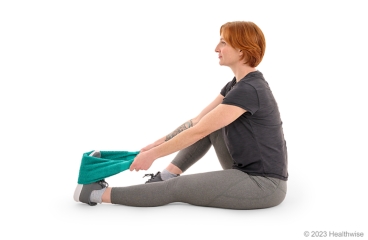
slide 1 of 10
slide 1 of 10, Calf stretch (seated, knee straight),
- Sit on the floor with your affected leg straight and resting on the floor.
- Place a towel around your affected foot.
- Hold one end of the towel in each hand.
- Pull back gently with the towel so that you feel a stretch in your calf.
- Hold the position for 15 to 30 seconds.
- Repeat 2 to 4 times.
- It's a good idea to repeat these steps with your other leg.
Calf stretch (seated, knee bent)
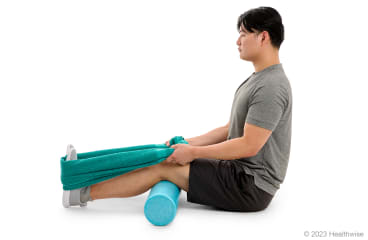
slide 2 of 10
slide 2 of 10, Calf stretch (seated, knee bent),
- Sit on the floor with your affected leg straight and resting on the floor. (Or you can sit on any flat surface, such as a bed.)
- Place a pillow or foam roll under the knee of your affected leg.
- Place a towel around your affected foot under the ball of that foot.
- Hold one end of the towel in each hand.
- Pull back gently with the towel so that you feel a stretch in your calf.
- Hold the position for 15 to 30 seconds.
- Repeat 2 to 4 times.
- It's a good idea to repeat these steps with your other leg.
Ankle plantar flexion
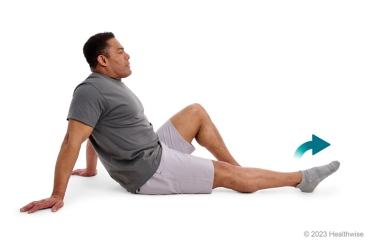
slide 3 of 10
slide 3 of 10, Ankle plantar flexion,
- Sit with your affected leg straight and resting on the floor. Your other leg should be bent, with that foot flat on the floor.
- Keeping your affected leg straight, gently flex your foot downward so your toes are pointed away from your body. Then slowly relax your foot to the starting position.
- Repeat 8 to 12 times.
- It's a good idea to repeat these steps with your other foot.
Ankle dorsiflexion

slide 4 of 10
slide 4 of 10, Ankle dorsiflexion,
- Sit with your affected leg straight and supported on the floor. Your other leg should be bent, with that foot flat on the floor.
- Keeping your leg straight, gently flex your foot back so your toes point upward. Then slowly relax your foot to the starting position.
- Repeat 8 to 12 times.
- It's a good idea to repeat these steps with your other leg.
Resisted ankle plantar flexion
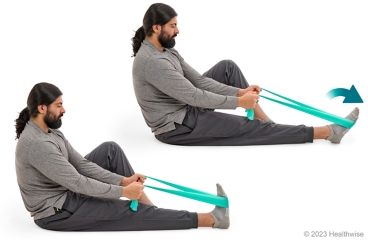
slide 5 of 10
slide 5 of 10, Resisted ankle plantar flexion,
- Sit with your affected leg straight and resting on the floor.
- Place an exercise band around your affected foot just under the toes.
- Hold each end of the band in each hand, with your hands above your knees.
- Keeping your affected leg straight, gently flex your foot downward so your toes are pointed away from your body. Then slowly relax your foot to the starting position.
- Repeat 8 to 12 times.
- It's a good idea to repeat these steps with your other leg.
Resisted ankle dorsiflexion

slide 6 of 10
slide 6 of 10, Resisted ankle dorsiflexion,
- Tie the ends of an exercise band together to form a loop. Attach one end of the loop to a secure object, or shut a door on it to hold it in place. (Or you can have someone hold one end of the loop to provide resistance.)
- Sit on the floor or in a chair, and loop the other end of the band over the top of your affected foot.
- Keeping your knee and leg straight, slowly flex your foot back toward you so you are pulling back on the exercise band. Then slowly return to the starting position.
- Repeat 8 to 12 times.
- It's a good idea to repeat these steps with your other foot.
Resisted ankle inversion
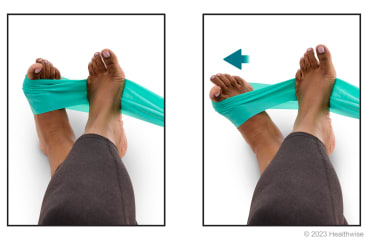
slide 7 of 10
slide 7 of 10, Resisted ankle inversion,
- Sit on the floor with your legs straight out in front of you. Cross your good leg over your affected leg.
- Hold both ends of an exercise band in one hand and loop the band around the inside of your affected foot. Then press your other foot against the band.
- Keeping your legs crossed, slowly push your affected foot against the band so that foot moves away from your other foot. Then slowly relax.
- Repeat 8 to 12 times.
- It's a good idea to repeat these steps with your other leg.
Resisted ankle eversion
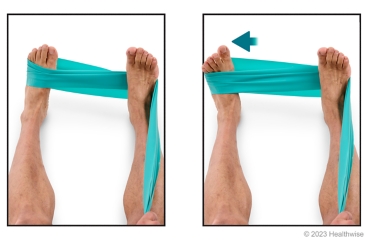
slide 8 of 10
slide 8 of 10, Resisted ankle eversion,
- Sit on the floor with your legs straight.
- Hold both ends of an exercise band in one hand and loop the band around the outside of your affected foot. Then press your other foot against the band.
- Keeping your leg straight, slowly push your affected foot outward against the band and away from your other foot without letting your leg rotate. Then slowly relax.
- Repeat 8 to 12 times.
- It's a good idea to repeat these steps with your other foot.
Ankle alphabet
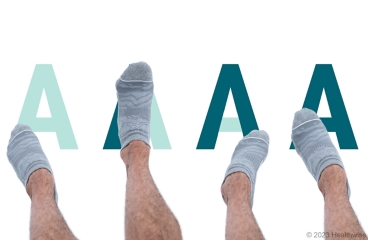
slide 9 of 10
slide 9 of 10, Ankle alphabet,
- Sit in a chair with your feet flat on the floor. (You can also do this exercise lying on your back with your affected leg propped up on a pillow).
- Lift the heel of your affected foot off the floor, and slowly trace the letters of the alphabet.
- It's a good idea to repeat these steps with your other foot.
Heel raise
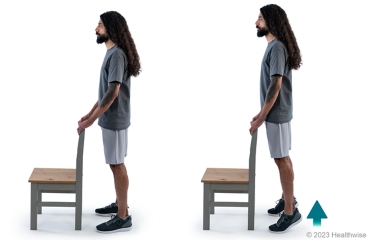
slide 10 of 10
slide 10 of 10, Heel raise,
- Stand with your feet a few inches apart, with your hands lightly resting on a counter or chair in front of you.
- Slowly raise your heels 1 to 2 inches off the floor while keeping your knees straight. Hold for about 6 seconds, then slowly lower your heels to the floor.
- Repeat 8 to 12 times.
Current as of: July 24, 2025
Author: Ignite Healthwise, LLC Staff
Clinical Review Board
All Ignite Healthwise, LLC education is reviewed by a team that includes physicians, nurses, advanced practitioners, registered dieticians, and other healthcare professionals.

